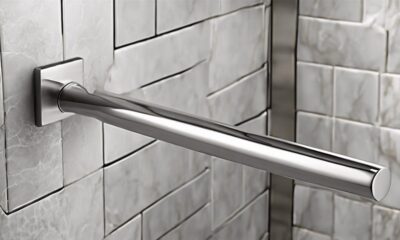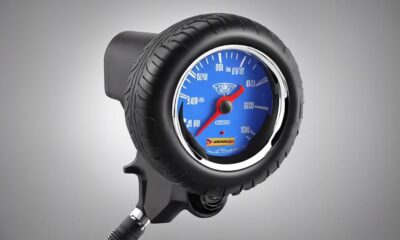Appliances
What Is the Average Speed of a Ceiling Fan?
2025
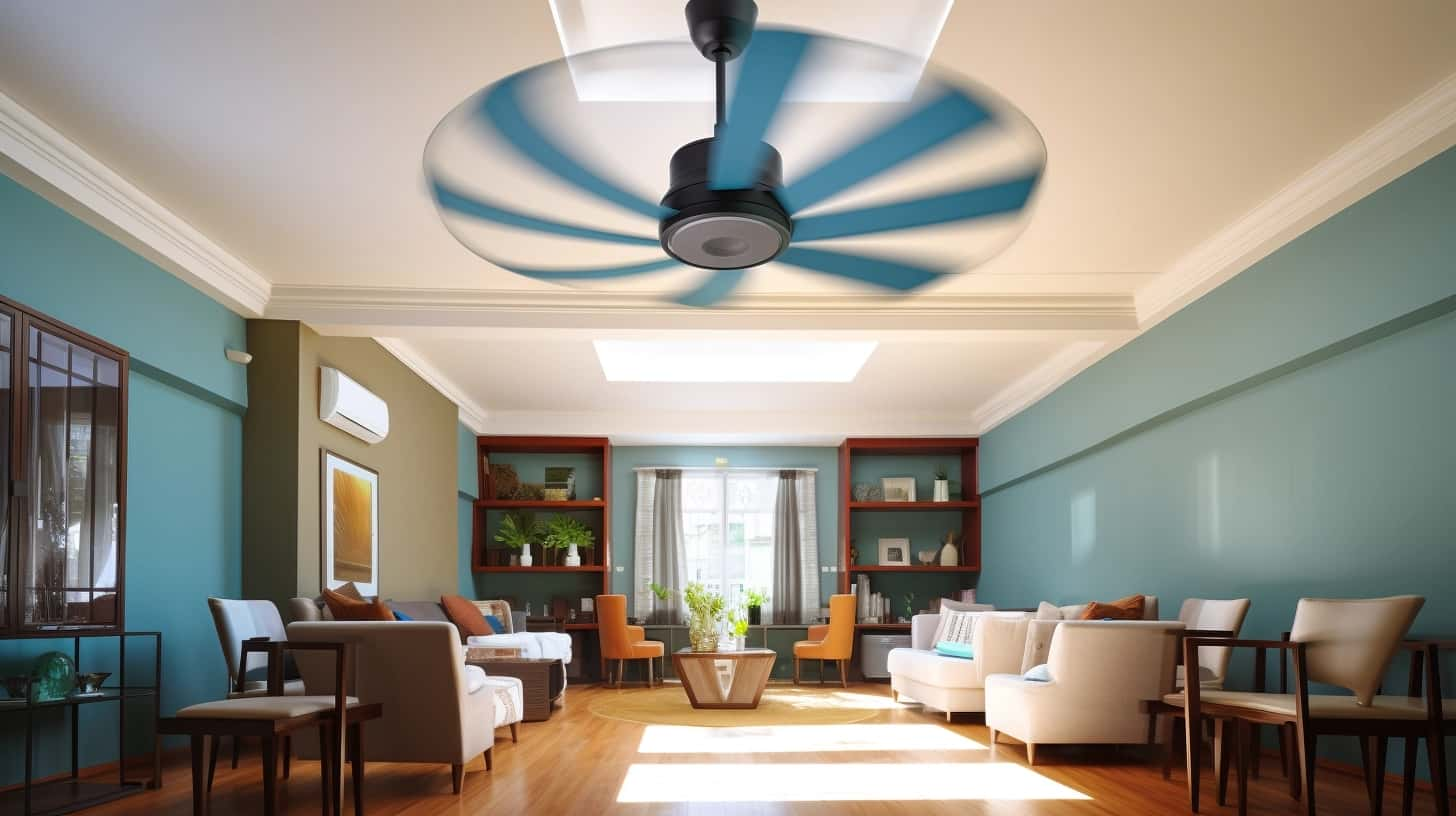
Ceiling fans, often seen in numerous homes, quietly rotate to produce a calming airflow. Yet, have you pondered over the typical speed at which a ceiling fan operates?
In this article, we will explore the factors that affect the speed of a ceiling fan, as well as how to measure it accurately. Understanding the average speed range for ceiling fans can help you choose the right one for your specific needs.
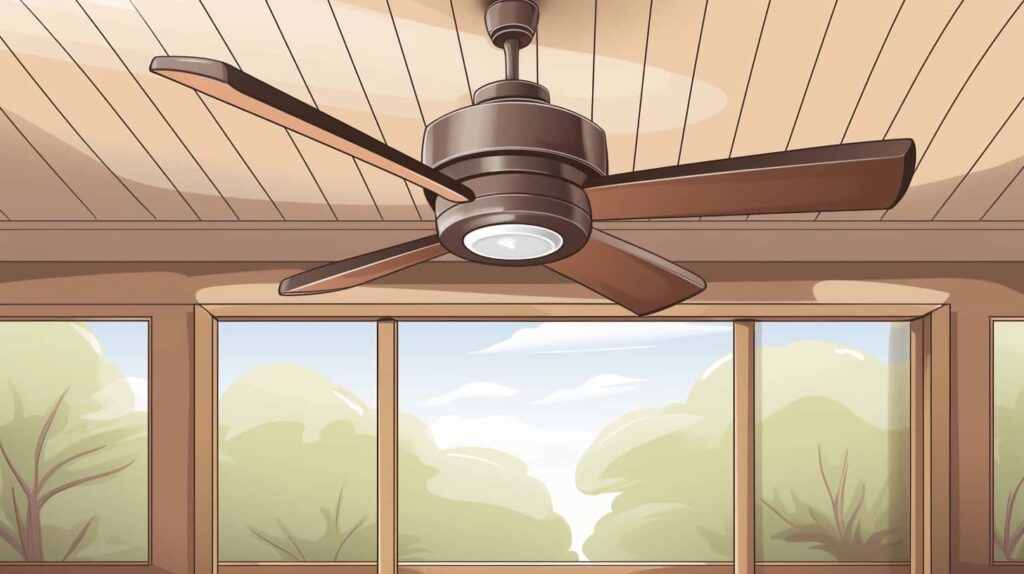
So, let’s delve into the world of ceiling fan speed and uncover the secrets behind this essential household appliance.
Key Takeaways
- Ceiling fan speed directly impacts comfort and energy efficiency
- Factors affecting ceiling fan speed include blade angle, motor power, number of blades, and design and shape of blades
- RPM (Revolutions per Minute) helps calculate airflow efficiency and energy consumption, with higher RPM resulting in increased airflow
- Ceiling fans offer multiple speed settings, typically measured in RPM, to accommodate different preferences and room sizes
Importance of Ceiling Fan Speed
The importance of ceiling fan speed can’t be overstated as it directly impacts the comfort and energy efficiency of a room. The speed at which a ceiling fan rotates plays a crucial role in creating the desired airflow and maintaining a comfortable environment.
When it comes to energy consumption, the speed setting of a ceiling fan can significantly affect the amount of electricity it uses. Higher fan speeds generate stronger air circulation, which enhances the cooling effect in a room. This means that at higher speeds, the air movement is more powerful, resulting in faster and more efficient cooling.
On the other hand, lower speeds provide a gentle breeze that’s ideal for maintaining a comfortable temperature in mildly warm conditions. The impact of speed on air circulation is closely tied to the energy consumption of a ceiling fan. Running a fan at a higher speed consumes more electricity compared to running it at a lower speed.
Therefore, it’s crucial to strike a balance between energy efficiency and desired comfort levels when selecting the appropriate speed setting for your ceiling fan.
Factors Affecting Ceiling Fan Speed
What factors contribute to the speed of a ceiling fan?
The speed of a ceiling fan is influenced by various factors that affect the airflow it produces. One of the key factors is the blade angle or pitch. The angle at which the fan blades are set determines the amount of air that the fan can move. A steeper blade angle can generate higher airflow, while a shallower angle produces less airflow.
Another factor that affects ceiling fan speed is the motor power. A more powerful motor can spin the blades at a higher speed, resulting in increased airflow.

Additionally, the number of fan blades also plays a role in determining the speed. Ceiling fans with more blades tend to move air at a slower speed compared to those with fewer blades.
The design and shape of the blades also impact the speed of a ceiling fan. Blades that are aerodynamically designed can create more airflow, allowing for higher fan speeds. Similarly, the length of the blades can affect the speed as longer blades can move more air than shorter ones.
It’s important to note that the speed of a ceiling fan can also be influenced by external factors such as the room size, ceiling height, and any obstructions in the fan’s path.
Understanding RPM (Revolutions per Minute)
Understanding RPM, or revolutions per minute, is crucial for comprehending the speed at which a ceiling fan operates. RPM refers to the number of complete rotations a fan blade makes in one minute. It’s a key parameter that directly affects the airflow generated by the fan.
To understand the relationship between RPM and fan speed, it’s important to consider the concept of motor power. The motor power of a ceiling fan determines its ability to rotate the blades at a certain RPM. Higher motor power allows for faster blade rotations, resulting in increased airflow.
Calculating the airflow efficiency of a ceiling fan involves understanding the RPM. By measuring the RPM and the fan’s power consumption, you can determine how effectively the fan converts electrical power into airflow. This efficiency measurement is important for choosing a ceiling fan that provides optimal airflow while minimizing energy consumption.
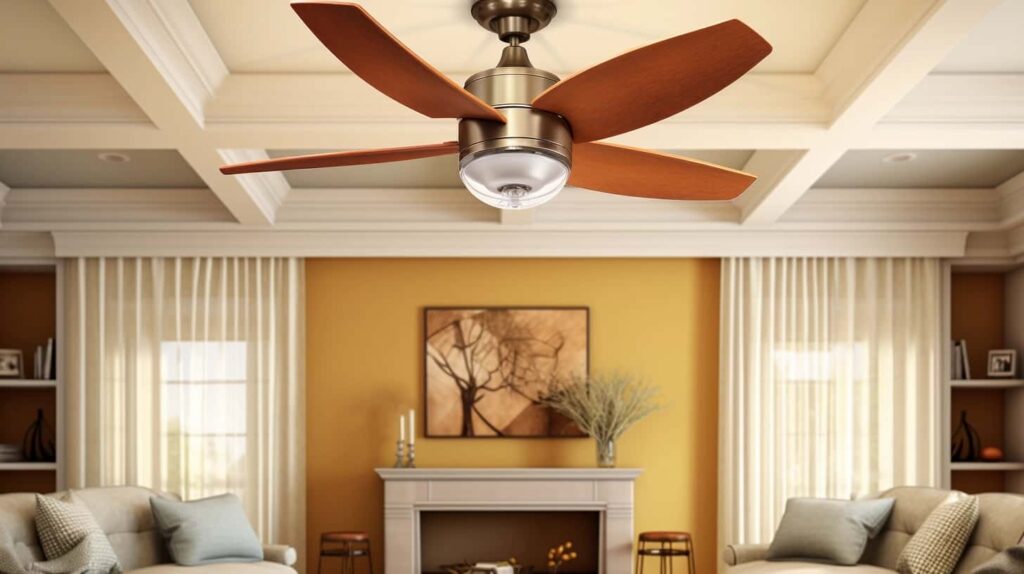
Average Speed Range for Ceiling Fans
As we explore the average speed range for ceiling fans, it’s important to consider the various speed settings available. Ceiling fans typically offer multiple speed options, allowing users to adjust the fan’s rotation speed to their preference.
Additionally, it’s worth noting the maximum speed capability of a ceiling fan, as this can vary depending on the model and manufacturer.
Lastly, energy efficiency ratings play a crucial role in determining the average speed range, as fans with higher efficiency ratings tend to offer better speed control and performance.
Speed Settings Available
Ceiling fans typically offer a range of speed settings, allowing users to adjust the average speed to their desired level of comfort. Speed control options vary among different ceiling fan models, but the most common ones include three-speed and four-speed settings.
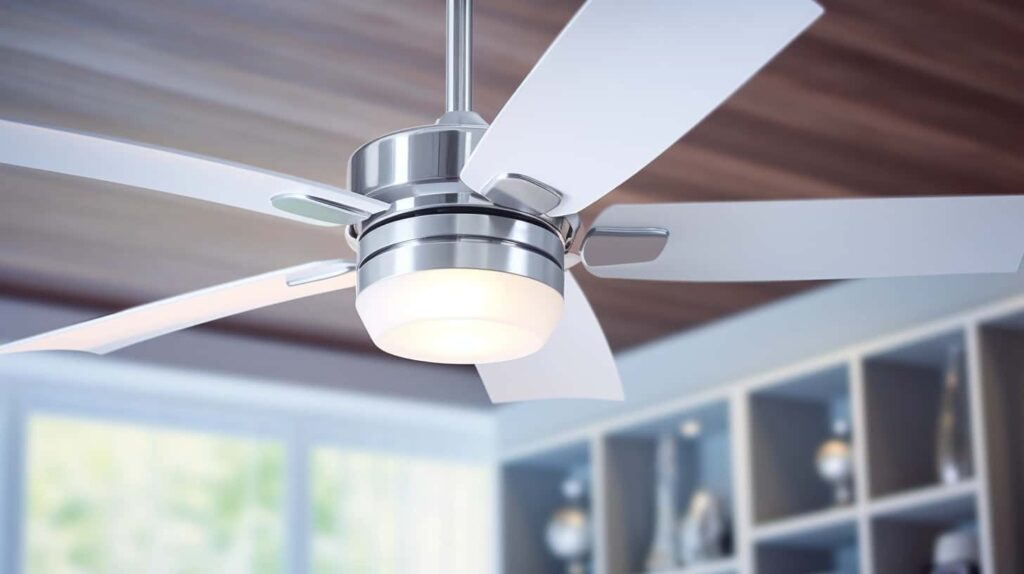
The three-speed setting typically has low, medium, and high speed options, while the four-speed setting adds an additional option for an even higher speed. These speed settings are designed to accommodate different preferences and room sizes. It’s important to note that the average speed range for ceiling fans is measured in rotations per minute (RPM).
Additionally, noise level measurements can also vary depending on the speed setting. Generally, the higher the speed, the louder the fan may sound. Therefore, users can choose a speed setting that not only provides the desired airflow but also maintains a comfortable noise level.
Maximum Speed Capability
The maximum speed capability of a ceiling fan refers to the range of average speeds that can be achieved by the fan.
Ceiling fans are equipped with different speed settings that allow users to adjust the fan’s rotation speed according to their preferences.
The maximum speed control determines the highest average speed at which the fan can operate. This capability is important because it affects the fan’s ability to provide optimal airflow in a room.
When the fan operates at its maximum speed, it can create a stronger breeze, increasing the circulation of air and promoting better ventilation. This can be particularly beneficial in larger rooms or during hot summer days when a higher airflow is desired.
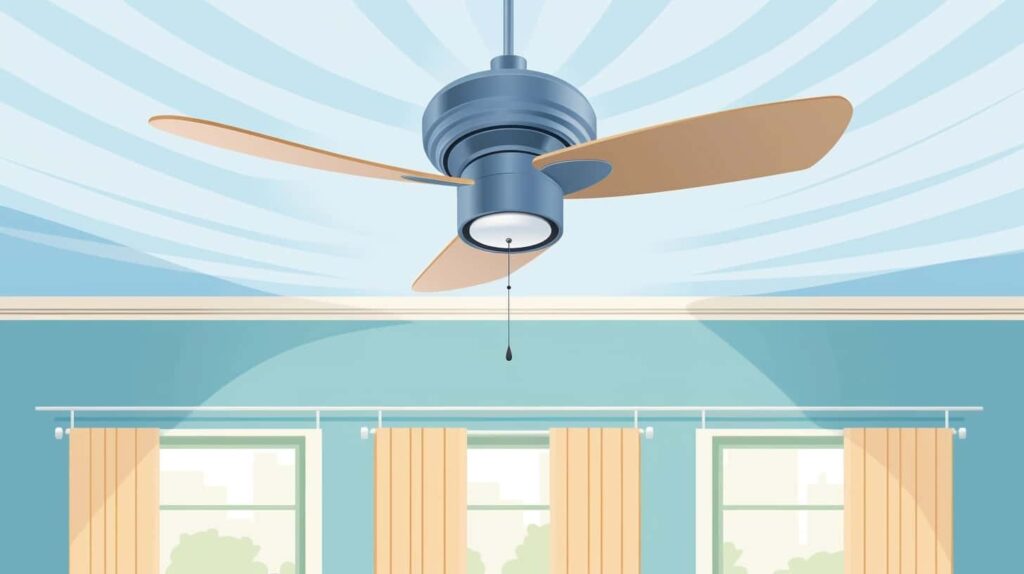
Energy Efficiency Ratings
To determine the energy efficiency ratings of ceiling fans, it’s essential to analyze the average speed range at which they operate. The speed at which a fan operates directly affects its energy consumption and impact on airflow quality.
Here are two key factors to consider when assessing the energy efficiency of ceiling fans:
- Energy Consumption Analysis:
- The average speed range of a fan determines the amount of energy it consumes. Fans operating at higher speeds generally consume more energy than those operating at lower speeds.
- It’s important to consider the energy consumption of a fan over its entire speed range to accurately assess its energy efficiency.
- Impact on Airflow Quality:
- The average speed range also influences the quality of airflow produced by a ceiling fan. Higher speeds can generate stronger airflow, while lower speeds provide a more gentle breeze.
- The airflow quality should be balanced with energy consumption to ensure optimal comfort and efficiency.
Analyzing the average speed range allows for a comprehensive assessment of a ceiling fan’s energy efficiency and its impact on airflow quality.
How to Measure the Speed of a Ceiling Fan
Using a tachometer, we can accurately measure the speed of a ceiling fan. A tachometer is a device that measures the rotational speed of an object. To measure the speed of a ceiling fan, we need to place the tachometer near the fan blades. The tachometer uses a laser or an optical sensor to detect the rotational movement of the blades. It then calculates the speed based on the number of rotations per minute (RPM).
Measuring the speed of a ceiling fan is crucial for several reasons. Firstly, it allows us to determine the accuracy of the fan’s speed settings. By comparing the measured speed with the manufacturer’s specifications, we can ensure that the fan is operating as intended. Secondly, it helps us identify any speed variations that may occur over time. Speed variations can indicate issues with the motor or other components, which may require maintenance or repair.
To obtain accurate measurements, it’s recommended to take multiple readings at different fan speeds and average them. This helps to minimize any potential errors or fluctuations in the readings. Additionally, it’s important to position the tachometer at a fixed distance from the blades to ensure consistent measurements.

Tips for Choosing the Right Ceiling Fan Speed
When choosing the right speed for a ceiling fan, there are a few key points to consider.
Firstly, it’s important to understand the speed control options available, such as multiple speed settings or remote control capabilities.
Secondly, energy efficiency should be taken into account, as higher speeds may consume more electricity.
Lastly, noise level considerations should be made, as fans operating at higher speeds tend to generate more noise.
Speed Control Options
We can optimize the performance of our ceiling fan by carefully selecting the appropriate speed control option. When it comes to speed control options, there are several choices available to us. Here are two main sub-lists to consider:
- Wall-mounted control options:
- Rotary dial: This traditional control option allows us to adjust the fan speed by turning a dial on the wall. It provides a simple and intuitive way to select the desired speed setting.
- Slide switch: A slide switch control option offers a more modern and sleek design. It allows us to easily slide the switch up or down to adjust the fan speed smoothly.
- Remote control options:
- Handheld remote: This convenient option allows us to adjust the fan speed from anywhere in the room. It typically offers multiple speed settings and may also include additional features such as a timer or light control.
- Wall-mounted remote: With this option, we can mount the remote control on the wall for easy access. It provides the same functionality as a handheld remote but offers a more permanent solution.
Carefully considering these speed control options will help us find the perfect fit for our ceiling fan, ensuring optimal performance and comfort.
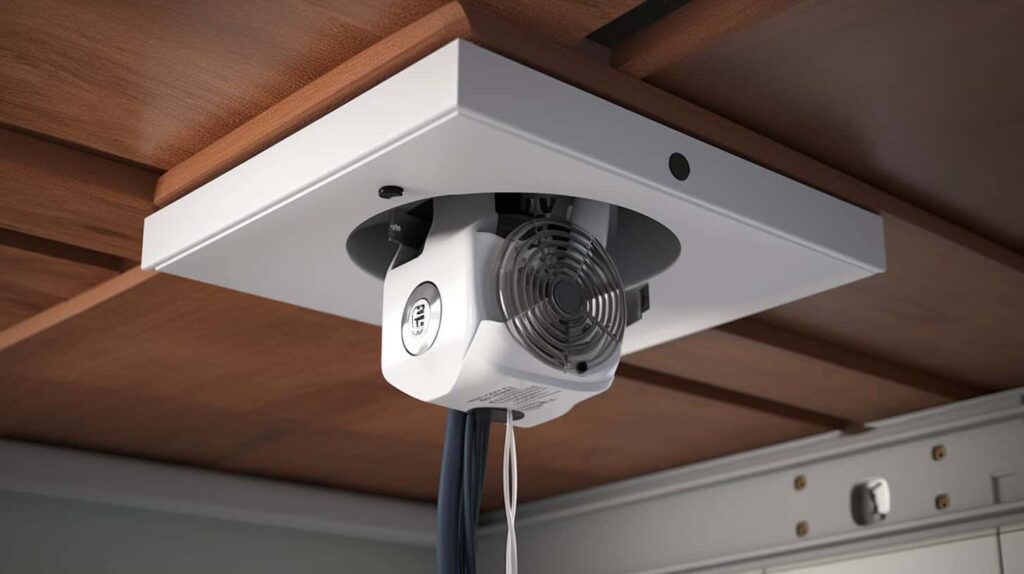
Energy Efficiency Considerations
To enhance energy efficiency, selecting the appropriate ceiling fan speed is crucial. By understanding the relationship between ceiling fan airflow and speed control technologies, you can optimize your fan’s performance while minimizing energy consumption.
Ceiling fan airflow is directly influenced by the speed at which the fan blades rotate. Higher speeds create more airflow, which can help cool a room more quickly. However, running the fan at high speeds continuously can increase energy usage and may not be necessary for maintaining comfort.
Modern ceiling fans often come equipped with speed control technologies, such as multiple speed settings or variable speed controls. These features allow you to adjust the fan’s speed to match your cooling needs. Lower speeds are generally more energy-efficient and can still provide a comfortable breeze.
When choosing the right ceiling fan speed, consider the size of the room, the desired level of cooling, and the fan’s efficiency rating. By using speed control technologies effectively, you can strike the perfect balance between energy efficiency and comfort in your space.
Noise Level Considerations
Considering the noise level of a ceiling fan is an important factor when choosing the appropriate fan speed for your space. A ceiling fan with silent operation ensures a peaceful environment, especially during sleep.
Here are two key considerations regarding noise level:
- Motor Quality:
- A high-quality motor reduces noise levels significantly.
- Look for fans with motors specifically designed to minimize noise.
- Blade Design:
- Fans with specially designed blades reduce air turbulence, resulting in quieter operation.
- Opt for fans with aerodynamically balanced blades to minimize noise.
When selecting a ceiling fan, prioritize those that offer a silent operation to avoid any disturbance that can impact sleep quality. A fan with a quiet motor and well-designed blades will ensure a peaceful and serene atmosphere in your space.
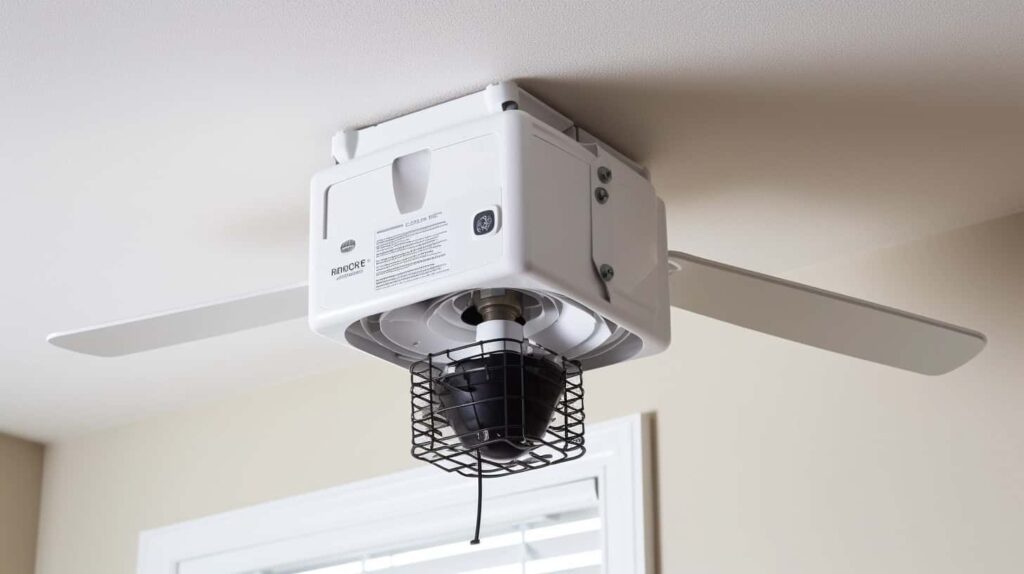
Frequently Asked Questions
Can the Speed of a Ceiling Fan Affect the Temperature in a Room?
The speed of a ceiling fan can indeed affect the temperature in a room. When a ceiling fan is set to a higher speed, it creates a stronger breeze, which aids in evaporating sweat from our skin, making us feel cooler. This enhanced air circulation helps to disperse heat and humidity, creating a more comfortable environment.
Additionally, higher speed settings can also increase energy consumption, so it’s important to strike a balance between comfort and efficiency.
Are There Any Safety Concerns Associated With Operating a Ceiling Fan at High Speeds?
When operating a ceiling fan at high speeds, it’s important to consider safety precautions and potential risks. High-speed operation may result in increased noise levels and vibration, which could potentially lead to loose or damaged components.
Additionally, the motor durability may be affected, leading to shorter lifespan of the fan. It’s advisable to regularly inspect and maintain the fan to ensure proper operation and minimize any safety concerns associated with high-speed usage.
Can Ceiling Fan Speed Be Adjusted Remotely?
Yes, ceiling fan speed can be adjusted remotely. Remote-controlled ceiling fans have become increasingly popular due to their convenience and ease of use. With a ceiling fan remote control, you can effortlessly change the fan speed from the comfort of your couch or bed.
This feature is especially beneficial for those with limited mobility or for those who want to adjust the fan speed without getting up. Remote-controlled fans provide a seamless and efficient way to control your fan’s speed and create a comfortable environment in your space.
Is It Possible to Install a Variable Speed Controller for a Ceiling Fan?
Installing a variable speed controller for a ceiling fan can provide numerous benefits. It allows for precise control over the fan’s speed, allowing us to adjust it to our desired level of comfort. Additionally, it can help save energy by reducing the fan’s speed when less cooling is required.
However, there are some drawbacks to consider. The installation process may require technical expertise, and not all ceiling fans are compatible with variable speed controllers.
How Does the Size of a Ceiling Fan Blade Impact Its Speed?
When considering the impact of blade size on a ceiling fan’s speed, it’s important to take into account factors such as blade material and the number of blades.
The blade size can affect the airflow generated by the fan, potentially increasing or decreasing the speed. Additionally, the material and number of blades can also contribute to the overall speed performance.
Therefore, when selecting a ceiling fan, it’s crucial to consider these factors to ensure optimal speed and airflow.
Conclusion
In conclusion, the average speed of a ceiling fan is surprisingly unremarkable. Despite the importance of ceiling fan speed and the various factors that can affect it, the average range falls within a relatively mundane spectrum.
Furthermore, measuring the speed of a ceiling fan can be a straightforward process, eliminating any mystique surrounding this seemingly ordinary household appliance.
So next time you turn on your ceiling fan, remember that its average speed may not be as thrilling as you might expect.
- About the Author
- Latest Posts
Introducing Ron, the home decor aficionado at ByRetreat, whose passion for creating beautiful and inviting spaces is at the heart of his work. With his deep knowledge of home decor and his innate sense of style, Ron brings a wealth of expertise and a keen eye for detail to the ByRetreat team.
Ron’s love for home decor goes beyond aesthetics; he understands that our surroundings play a significant role in our overall well-being and productivity. With this in mind, Ron is dedicated to transforming remote workspaces into havens of comfort, functionality, and beauty.
Garage Door Opener
Wiring Your Liftmaster Garage Door Opener: 3 Easy Steps
Uncover the secrets to effortlessly wiring your Liftmaster garage door opener with finesse, ensuring a secure and functional setup that you won't want to miss.

Let’s discuss the important process of making sure your Liftmaster garage door opener is correctly connected with precision. By following these simple steps, you can effectively handle the wiring of your system.
Curious about how to seamlessly integrate your garage door opener into your home? Stay tuned as we navigate through the crucial steps together, demystifying the process for a secure and functional setup that you won't want to miss.
Key Takeaways
- Properly wire power supply to opener terminals for electrical connection.
- Connect control panel to opener with correct wire placement for functionality.
- Install safety sensors across from each other and connect to opener securely.
- Maintain remote control functionality and opener longevity through regular checks and lubrication.
Wiring the Power Source
To wire the power source for your Liftmaster garage door opener, connect the designated power source wires to the specified terminals on the opener, ensuring proper polarity by matching positive and negative terminals securely using a screwdriver.
Begin by identifying the power supply wires coming from the electrical outlet. Strip the insulation at the ends of the wires to expose the conductive material.
Next, locate the screw terminals on the garage door opener, usually found near the mounting bracket. Insert the positive wire into the corresponding positive terminal, ensuring a snug fit. Repeat the process for the negative wire, inserting it into the negative terminal.
Use the screwdriver to tighten the screws, securing the wires in place. Double-check the connections to guarantee no loose wires that could lead to malfunctions. Confirm the voltage requirements of the garage door opener match those of the power supply to prevent damage.
This meticulous approach ensures a safe and efficient power supply for your garage door opener.
Connecting the Control Panel

Mount the control panel of your Liftmaster garage door opener within sight of the door for convenient access and operational efficiency. When connecting the control panel, ensure proper polarity of the wires to guarantee functionality.
Here are essential steps to follow:
- Secure Mounting: Attach the control panel securely to the wall to prevent any unwanted movement during operation.
- Wiring: Run the wires from the control panel to the garage door opener and connect them to the designated terminals following the manufacturer's instructions.
- Warning Placard: Affix the warning placard near the control panel as a safety reminder for users interacting with the garage door opener.
Proper installation of the control panel is crucial for the overall performance of your Liftmaster garage door opener. By following these steps diligently, you can ensure a smooth and efficient operation of your garage door system.
Securing Safety Sensors
When securing safety sensors for your Liftmaster garage door opener, ensure precise alignment and proper wiring to guarantee optimal functionality and safety. The sensors, crucial for detecting obstacles in the path of the garage door, work by transmitting an invisible light beam.
Start by mounting the sensors across from each other on the wall, using the provided mounting brackets. It's essential to align the sensors correctly to ensure the invisible light beam path is unobstructed. Use staples to secure the sensor wiring along the wall, keeping it neat and out of the way.
When wiring, connect the sensor wires to the appropriate terminals on the Liftmaster garage door opener, following the manufacturer's safety guidelines. Remember always to disconnect the power to the opener before installation to prevent any accidents.
Frequently Asked Questions
How Do I Connect My Liftmaster Garage Door Opener?
To connect your Liftmaster garage door opener, follow these steps:
- Locate and identify the terminals on the opener connected to the wall button, typically labeled 1 and 2.
- Using a screwdriver, release the push-type terminals and securely insert the stripped ends of hookup wires.
- Connect the wires from the wall button to the designated terminals on the garage door motor unit.
- Ensure proper wire management by securing and hiding the wires to avoid interference with the door's operation.
How Many Wires Do You Need for a Garage Door Opener?
When setting up a garage door opener, we typically require a minimum of 2 wires for standard functionality. However, some advanced models might necessitate extra wires for specific features.
These wires establish the connection between the control panel/remote and the opener motor, enabling signal transmission for door operation.
Ensuring proper wiring is crucial for optimal performance of your Liftmaster garage door opener.
How Do You Wire a Push Button Garage Door Opener?
When wiring a push button garage door opener, we start by identifying the terminals on the opener that connect to the push button.
Using a screwdriver, we release and insert the stripped ends of hookup wires into the designated terminals on the motor unit.
We then ensure a secure connection by twisting and fastening the wires.
Proper wire routing is crucial to prevent interference with the garage door's operation.
How to Program the Garage Door Opener in Your Car in 3 Easy Steps?
When programming your garage door opener in your car, locate the 'Learn' button on the opener motor unit. Press and release it, then swiftly return to your car to hold the desired button for programming. Wait for the light to flash or hear two clicks to confirm.
Test the button to ensure successful programming.
These steps are essential for seamless operation of your Liftmaster system.
Conclusion
In conclusion, wiring your Liftmaster garage door opener is as simple as connecting the dots. Just like a skilled electrician effortlessly navigates a circuit board, you can confidently wire your opener with ease.
By following the three easy steps outlined, you'll have your garage door opener up and running smoothly in no time.
So, grab your tools and get ready to bring power to your garage door with precision and confidence.
- About the Author
- Latest Posts
Introducing Ron, the home decor aficionado at ByRetreat, whose passion for creating beautiful and inviting spaces is at the heart of his work. With his deep knowledge of home decor and his innate sense of style, Ron brings a wealth of expertise and a keen eye for detail to the ByRetreat team.
Ron’s love for home decor goes beyond aesthetics; he understands that our surroundings play a significant role in our overall well-being and productivity. With this in mind, Ron is dedicated to transforming remote workspaces into havens of comfort, functionality, and beauty.
Garage Door Opener
Choosing the Right Size Battery for Your Garage Door Opener
Find out why selecting the perfect battery size for your garage door opener is crucial for avoiding disruptions and ensuring smooth operation.

We’ve all experienced it – 70% of garage door opener malfunctions are caused by battery problems. Choosing the correct size battery is crucial for smooth operation.
But how do you know which battery is the perfect fit for your opener? Let's shed light on this essential aspect to keep your garage running smoothly and avoid unexpected disruptions.
Key Takeaways
- Consider manufacturer's voltage requirements for optimal performance.
- Choose the correct battery size for longer opener lifespan.
- Rechargeable batteries offer cost-effectiveness and consistent power.
- Adhere to manufacturer's recommendations for efficient operation.
Factors to Consider When Choosing Battery Size
When selecting the appropriate battery size for your garage door opener, it's crucial to carefully consider the voltage requirements specified by the manufacturer. Adhering to the manufacturer's recommendations ensures that the battery size is compatible with your garage door opener, providing the necessary power source for optimal performance. Choosing the correct battery size not only allows for efficient operation but also contributes to a longer lifespan for your garage door opener.
Opting for a rechargeable battery can be a practical choice, offering the advantage of being reusable and environmentally friendly. Rechargeable batteries provide a cost-effective solution in the long run, as they can be recharged multiple times before needing replacement. Additionally, they often have a higher capacity compared to disposable batteries, ensuring a consistent power supply to your garage door opener.
Types of Batteries for Garage Openers

For selecting the appropriate battery type for garage door openers, consideration of lithium, alkaline, and rechargeable options is essential based on their power characteristics and longevity.
When it comes to garage door opener batteries, here are the options to consider:
- Lithium Batteries: Known for their long-lasting power and reliability, lithium batteries are commonly used in garage door opener remote controls.
- Alkaline Batteries: Offering a non-rechargeable but reliable power source, alkaline batteries are another viable option for garage door openers.
- Rechargeable Batteries: Rechargeable options like nickel-cadmium (NiCd) and lithium-ion (Li-ion) provide sustainability and cost-effectiveness for long-term use in garage door openers.
- Manufacturer's Recommendations: Battery size and type depend on the specific brand and model of the garage door opener, so it's crucial to check the manufacturer's recommendations to ensure optimal performance and prevent malfunctions.
Popular Battery Brands for Openers
Among the array of battery brands available for garage door openers, Duracell stands out for its reputation of delivering enduring power and exceptional performance.
Known for their long-lasting power and reliable performance, Energizer batteries are a popular choice for various garage door opener models.
Panasonic batteries are recognized for their durability, reliability, and high energy output, making them a preferred option for many users.
Rayovac offers value for money with its combination of long-lasting performance and reliability, making it a top contender in the market of garage door opener batteries.
Eveready also provides dependable options for garage door opener batteries, ensuring consistent power and performance.
When choosing the right battery for your garage door opener, considering these popular brands can help you find the optimal balance between longevity, reliability, and performance for your specific needs.
How to Replace Garage Door Opener Battery

Having identified the specific battery type required for your garage door opener, the next step is to open the remote control cover correctly to access the battery compartment for replacement.
When replacing the battery for your garage door opener, follow these steps:
- Open the Cover: Gently slide the cover of the remote control in the direction indicated to reveal the battery compartment.
- Remove the Old Battery: Carefully take out the old battery by pushing it gently from the sides to release it from the connectors.
- Insert the New Battery: Place the new battery in the compartment, ensuring the correct orientation as per the markings inside.
- Close the Cover: Once the new battery is securely in place, slide the cover back onto the remote control until it clicks shut.
Troubleshooting Tips for Battery Issues
To troubleshoot battery issues with your garage door opener, we recommend conducting a thorough inspection of the battery compartment and connections. Start by checking the brand and model of your garage door opener remote to determine the correct battery type needed for replacement. It's crucial to use the specific battery number designated by the manufacturer to prevent compatibility problems with your garage door opener.
If necessary, refer to the owner's manual or open the transmitter to identify the exact battery required for your remote control. Pay attention to any colored smart buttons on the remote, such as yellow ones for Security+ 2.0 models, which may indicate the particular battery type needed. Always ensure the proper functioning of your garage door opener remote by using the right battery number and avoiding substitutions to prevent any potential damage.
Frequently Asked Questions
What Size Battery Does My Garage Door Opener Take?
We must ascertain the specific battery size required by your garage door opener for optimal performance.
It's crucial to identify the manufacturer-specified battery number and the type indicated by the colored smart buttons on the remote control.
Accessing the battery compartment through the proper opening of the remote control cover is essential for replacement.
Ensuring the correct battery size will guarantee seamless operation of your garage door opener.
What Battery Is Best for Garage Door Opener?
We've found that longevity is crucial when selecting the best battery for a garage door opener, with lithium batteries lasting approximately 5 years.
It's vital to match the specific battery type recommended for your transmitter to avoid compatibility issues.
Do Garage Door Openers Need Special Batteries?
Yes, garage door openers do require special batteries. These batteries, like 3-volt lithium or 12-volt options, are crucial for reliable remote operation in various settings. Having the correct battery size is essential to prevent malfunctions and ensure smooth garage door operation.
Additionally, certain keypads and remote controls may need 9-volt batteries for backup power in keyless entry systems. Selecting the right size and type of battery is vital for consistent functionality.
What Battery Do I Need for Liftmaster Garage Door Opener?
We need a CR2016 or CR2032 3-volt lithium battery for our LiftMaster garage door opener.
It's crucial to check the model specifications for the correct battery type. Proper maintenance and timely battery replacement are essential for smooth operation.
Make sure to have the right battery on hand to avoid any disruptions in functionality.
Conclusion
In conclusion, selecting the appropriate battery size for your garage door opener is imperative for optimal performance. By considering factors such as capacity, lifespan, and voltage requirements, you can ensure smooth operation.
Choosing reputable brands like Duracell or Energizer and performing regular maintenance will further enhance reliability. Remember, a well-chosen battery can make all the difference between seamless functionality and unexpected disruptions.
Choose wisely for peace of mind.
- About the Author
- Latest Posts
Introducing Ron, the home decor aficionado at ByRetreat, whose passion for creating beautiful and inviting spaces is at the heart of his work. With his deep knowledge of home decor and his innate sense of style, Ron brings a wealth of expertise and a keen eye for detail to the ByRetreat team.
Ron’s love for home decor goes beyond aesthetics; he understands that our surroundings play a significant role in our overall well-being and productivity. With this in mind, Ron is dedicated to transforming remote workspaces into havens of comfort, functionality, and beauty.
Garage Door Opener
Cost-Effective LiftMaster Garage Door Opener Options
Get ready to explore cost-effective LiftMaster garage door opener options that offer a perfect blend of affordability and functionality, unlocking hidden treasures for your garage needs.

When considering cost-effective LiftMaster garage door openers, it can feel like navigating a maze full of hidden treasures just waiting to be discovered.
From the sturdy chain drive models to the sleek belt-operated ones and the space-saving wall-mounted units, each offers a unique blend of affordability and functionality.
But how do you determine which one strikes the perfect balance between cost and features?
Let's explore the key factors that could influence your decision and help you find the ideal LiftMaster opener for your garage needs.
Key Takeaways
- LiftMaster offers cost-effective chain drive openers with myQ technology and battery back-up.
- Affordable belt drive models provide smooth, quiet operation with steel-reinforced rubber belts.
- Wall-mount openers offer space-saving solutions with WiFi connectivity and automatic door lock.
- LiftMaster openers feature built-in WiFi, various drive systems, warranties, and compatibility with accessories.
LiftMaster Chain Drive Opener Prices
Have you considered the cost-effective LiftMaster chain drive opener prices ranging from $200 to $400 for your garage door needs? When it comes to finding a reliable and smart solution for your garage, the LiftMaster Chain Drive Garage Door Opener offers a range of features at accessible prices. Equipped with myQ technology, these openers allow you to control your garage door from anywhere using your smartphone. The convenience doesn't stop there – within this price range, you can choose from various motor options to suit your specific requirements.
In addition to the advanced technology, LiftMaster chain drive openers come with valuable features such as battery back-up systems, built-in lighting for added security, and warranties for peace of mind. Whether you're looking for a basic model or one with all the bells and whistles, LiftMaster offers a range of options that cater to different budgets and preferences. Upgrade your garage door opener to a smart and efficient solution without breaking the bank.
LiftMaster Belt Drive Opener Costs

Considering the affordability of LiftMaster chain drive opener prices, let's now explore the cost-effective range of LiftMaster belt drive opener options for your garage door needs. LiftMaster belt drive garage door openers typically range from $300 to $600, with popular models falling between $375 and $425, offering a balance of quality and affordability. These openers are renowned for their smooth and quiet operation, making them perfect for homes where noise reduction is essential. The steel-reinforced rubber belt ensures durability, and extension kits are available for 8 or 10-foot doors. Customers can rely on the reliable performance of LiftMaster belt drive garage door openers, all at a reasonable price point.
| Features | Description |
|---|---|
| Smooth and Quiet Operation | Ideal for noise reduction in residential settings |
| Steel Reinforced Rubber Belt | Ensures durability and longevity |
| Reliable Performance | Consistent operation you can count on |
LiftMaster Wall-Mount Opener Options
Exploring LiftMaster wall-mount opener options reveals premium solutions ideal for high or irregular ceilings, offering advanced features for enhanced control and security. When considering LiftMaster wall-mount openers, there are several key features to keep in mind:
- Direct Drive Operation: These openers operate without belts or chains, ensuring a smooth and quiet performance.
- WiFi Connectivity and Smart Technology: Enjoy advanced control and monitoring capabilities with options for connectivity to your smart devices.
- Automatic Door Lock: Enhance security with the automatic door lock feature, providing peace of mind when away from home.
- Space-Saving Installations in Residential Settings: Designed for convenience, these openers are ideal for saving space in residential garages, making them a practical choice for any home.
With prices ranging between $500-$600, LiftMaster wall-mount openers offer a reliable and efficient solution for those looking to optimize their garage door opener in unique ceiling situations while enjoying modern conveniences and enhanced security features.
LiftMaster Opener Features Overview

When moving on to discuss the 'LiftMaster Opener Features Overview,' it becomes evident that LiftMaster garage door openers offer a range of advanced features tailored to enhance convenience and security for users.
LiftMaster garage door openers are equipped with built-in WiFi, allowing for seamless operation through smart technology. With options like belt drive and chain drive systems, users can choose the mechanism that best suits their needs. Additionally, features such as battery back-up ensure that the opener functions even during power outages, providing peace of mind.
LiftMaster Garage Door Openers also come with innovative functions like automatic door lock and lifetime warranties, adding value to the user's investment. These openers can be further enhanced with accessories such as cameras, keypads, and motion alerts, offering added convenience and security.
With prices ranging from $200 to $600, LiftMaster provides cost-effective solutions for various budgets, making them a practical choice for those seeking reliable and feature-rich garage door openers.
Garage Door Opener Buying Tips
To make an informed decision when buying a garage door opener, it's essential to consider factors such as budget, required features, and installation requirements. When shopping for a garage door opener, keep in mind the following tips:
- Types of Garage Door Openers: Explore options like chain drive models for affordability or belt-operated models for a balance of quality and cost.
- Smart Home Integration: Consider smart-enabled devices that can be controlled through the LiftMaster myQ app for added convenience.
- Installation Requirements: Evaluate whether you need a wall-mounted opener for space-saving solutions.
- Material Preferences: Decide between a metal chain or a rubber belt based on noise levels and durability.
Frequently Asked Questions
What Is the Average Price of a Liftmaster Garage Door Opener?
We found that the average price of a LiftMaster garage door opener can range between $200 to $1,000.
Basic chain drive models start around $200, while advanced belt-operated ones go up to $600.
Wall-mounted direct drive openers can cost from $400 to $800, and smart-enabled models with WiFi features may range from $400 to $1,000.
Prices vary based on horsepower, additional features, and user preferences.
What Is the Best Liftmaster Garage Door Opener for 2023?
We believe the best LiftMaster garage door opener for 2023 is the LiftMaster Wall Mount Garage Door Opener. Priced between $500-$600+, this model offers premium features like automatic door lock, WiFi, and Smart technology.
It's a top pick for homeowners seeking advanced functionalities. With its innovative design and reliable performance, the LiftMaster Wall Mount Garage Door Opener stands out as a cutting-edge choice for modern garage automation needs.
Which Is a Better Garage Door Opener Genie or Liftmaster?
When comparing Genie and LiftMaster garage door openers, we prefer LiftMaster for its durability, reliability, and advanced security features.
While Genie may seem more budget-friendly initially, LiftMaster's long-term performance and compatibility with smart home systems make it the superior choice.
For enhanced safety and convenience, LiftMaster stands out with its solid warranties and smart technology integration.
What Is the Average Life of a Liftmaster Garage Door Opener?
We've got the scoop on the average lifespan of a LiftMaster garage door opener! These durable and reliable openers typically last around 10-15 years with regular maintenance.
Proper installation and periodic servicing can even extend their longevity. Factors like usage frequency, environmental conditions, and maintenance practices play a role in how long they'll last.
Investing in a quality LiftMaster opener can be a smart choice due to its extended lifespan.
Conclusion
In conclusion, when it comes to cost-effective garage door opener options, LiftMaster offers a range of models to suit different needs and budgets.
Whether you're looking for a chain drive, belt drive, or wall-mount opener, LiftMaster has you covered with features like WiFi connectivity, Smart technology, and battery backups.
Investing in a LiftMaster opener is like having a reliable guardian for your garage, providing security and peace of mind like a trusty shield.
- About the Author
- Latest Posts
Introducing Ron, the home decor aficionado at ByRetreat, whose passion for creating beautiful and inviting spaces is at the heart of his work. With his deep knowledge of home decor and his innate sense of style, Ron brings a wealth of expertise and a keen eye for detail to the ByRetreat team.
Ron’s love for home decor goes beyond aesthetics; he understands that our surroundings play a significant role in our overall well-being and productivity. With this in mind, Ron is dedicated to transforming remote workspaces into havens of comfort, functionality, and beauty.
-

 Decor1 week ago
Decor1 week agoMaximalist Decor Explained: Embrace More Style
-

 Vetted4 weeks ago
Vetted4 weeks ago15 Best Drip Irrigation Systems to Keep Your Garden Thriving
-

 Vetted2 weeks ago
Vetted2 weeks ago15 Best Foot Massagers for Neuropathy to Soothe Your Feet and Relieve Discomfort
-

 Vetted3 weeks ago
Vetted3 weeks ago15 Best Sports Laundry Detergents for Keeping Your Activewear Fresh and Clean
-

 Vetted3 weeks ago
Vetted3 weeks ago15 Best Tall Toilets for Seniors That Combine Comfort and Safety
-

 Vetted3 weeks ago
Vetted3 weeks ago15 Best Dish Scrubbers to Keep Your Kitchen Sparkling Clean
-

 Decor3 weeks ago
Decor3 weeks agoWhat Is Eclectic Home Decor
-

 Vetted4 days ago
Vetted4 days ago15 Best Organic Pest Control Solutions for a Naturally Pest-Free Home








